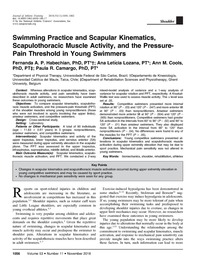Mostrar el registro sencillo de la publicación
Swimming practice and scapular kinematics, scapulothoracic muscle activity, and the pressure-pain threshold in young swimmers
| dc.contributor.author | Habechian-Zamuner, Fernanda A. | |
| dc.contributor.author | Lozana, Ana Letícia | |
| dc.contributor.author | Cools, Ann M. | |
| dc.contributor.author | Camargo, Paula R. | |
| dc.date.accessioned | 2019-07-08T15:38:40Z | |
| dc.date.available | 2019-07-08T15:38:40Z | |
| dc.date.issued | 2018 | |
| dc.identifier.uri | http://repositorio.ucm.cl/handle/ucm/2273 | |
| dc.description.abstract | Context Whereas alterations in scapular kinematics, scapulothoracic muscle activity, and pain sensitivity have been described in adult swimmers, no researchers have examined these outcomes in young swimmers. Objectives To compare scapular kinematics, scapulothoracic muscle activation, and the pressure-pain threshold (PPT) of the shoulder muscles among young nonpractitioners (those who were not involved in sports involving the upper limbs), amateur swimmers, and competitive swimmers. Design Cross-sectional study. Setting Laboratory. Patients or Other Participants A total of 90 individuals (age = 11.63 ± 0.61 years) in 3 groups: nonpractitioners, amateur swimmers, and competitive swimmers. Intervention(s) Scapular kinematics and activity of the upper trapezius, lower trapezius, and serratus anterior (SA) were measured during upper extremity elevation in the scapular plane. The PPT was assessed in the upper trapezius, infraspinatus, supraspinatus, middle deltoid, and tibialis anterior. Main Outcome Measure(s) Scapular kinematics, scapulothoracic muscle activation, and PPT. We conducted a 2-way mixed-model analysis of variance and a 1-way analysis of variance for scapular rotation and PPT, respectively. A Kruskal-Wallis test was used to assess muscle activity. The α level was set at .05. Results Competitive swimmers presented more internal rotation at 90° (P = .03) and 120° (P = .047) and more anterior tilt at 90° (P = .03) than nonpractitioners. Amateur swimmers demonstrated more anterior tilt at 90° (P = .004) and 120° (P = .005) than nonpractitioners. Competitive swimmers had greater SA activation in the intervals from 60° to 90° (P = .02) and 90° to 120° (P = .01) than amateur swimmers. They also displayed more SA activation in the interval from 90° to 120° than nonpractitioners (P = .04). No differences were found in any of the muscles for the PPT (P > .05). Conclusions Young competitive swimmers presented alterations in scapular kinematics and scapulothoracic muscle activation during upper extremity elevation that may be due to sport practice. Mechanical pain sensitivity was not altered in young swimmers. | es_CL |
| dc.language.iso | en | es_CL |
| dc.rights | Atribución-NoComercial-SinDerivadas 3.0 Chile | * |
| dc.rights.uri | http://creativecommons.org/licenses/by-nc-nd/3.0/cl/ | * |
| dc.source | Journal of Athletic Training, 53(11), 1056–1062 | es_CL |
| dc.subject | Biomechanics | es_CL |
| dc.subject | Shoulder | es_CL |
| dc.subject | Rehabilitation | es_CL |
| dc.subject | Athletes | es_CL |
| dc.title | Swimming practice and scapular kinematics, scapulothoracic muscle activity, and the pressure-pain threshold in young swimmers | es_CL |
| dc.type | Article | es_CL |
| dc.ucm.facultad | Facultad de Ciencias de la Salud | es_CL |
| dc.ucm.indexacion | Scopus | es_CL |
| dc.ucm.indexacion | Isi | es_CL |
| dc.ucm.doi | doi.org/10.4085/1062-6050-100-17 | es_CL |



